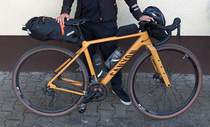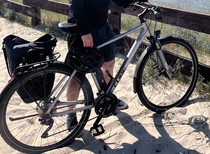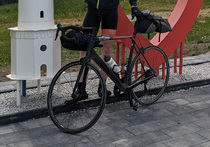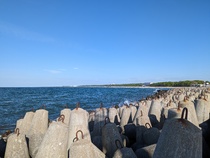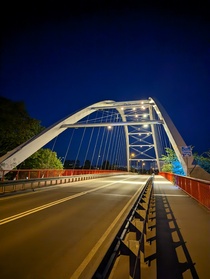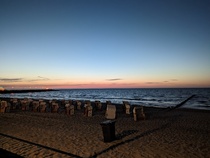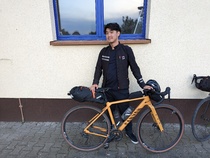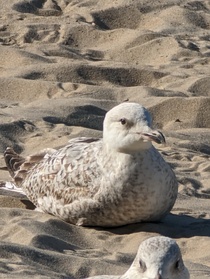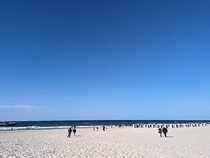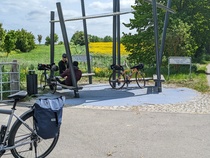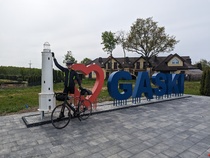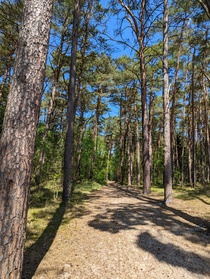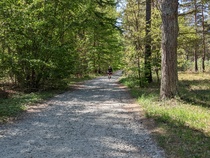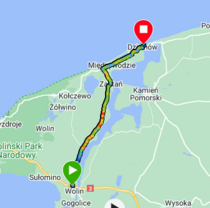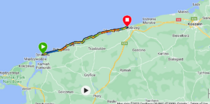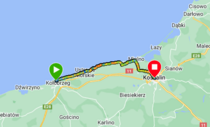Cycling: The Polish Baltic Sea Coast
I organised a few days of cycling with a couple of friends on the Polish coast of the Baltic Sea and it turned into a bike experiment.
I drafted up a rough potential route for mid-May from Szczecin to Gdansk which would be a total of 500km. One of my friends (Tom) is a trained cyclist who can do that within a single 24 hours so for him this route is not an issue. The other friend (Jim) has only casually cycled a single 80km trip in the past and so it was a bit uncertain how he’d fare. We set the expectations low and decided we’d casually cycle along the coast with no real destination set and simply see what happens.
The Experiment
Tom arrived in Berlin by plane with his Canyon Ultimate (2017 model) packed in a snug EVOC bike bag. His bike is a perfect road bike, with carbon frame and high end shimano components weighing in at only ~7kg, with Shimano SPD pedals to clip into to maximise efficiency and drop bars to get down into to optimise the aerodynamics. We took a test ride together from Berlin to Potsdam (~75km) and back with great results.
For the trip, Tom had a saddle bag and handlebar bag strapped on. These were very aero-esque. The saddle bag was a medium-sized Topeak bag and the handlebar bag was the smaller Ortlieb option.
Jim came by car with his Cube trekking bike stowed away in the boot. His bike was heavy and not aerodynamic in the least. It had a mountain bike style frame with commuter wheels (~40mm tyres) and flat handlebars. The group set was fairly high-end but it was definitely not a light bike (>10kg).
For the trip, Jim had a single pannier bag mounted on the left-hand side of the rear rack.
I was riding with my Canyon Grizl CF SL 6, this was a fairly non-aerodynamic carbon frame bike with a low end group set but still weighing in fairly light (~9kg). With 45mm tyres combined with drop bars, the bike sits in the confusing niche of trying to be a road bike that can handle being off-road.
For the trip, I had a similar set up to Tom, with an Ortlieb saddle bag and a Canyon handlebar bag and Canyon top tube bag. This was fairly aero-esque.
And so the realisation hit that we were basically doing an experiment where we’d see how the tour goes with the three styles of bikes: road, gravel, and trekking.
Train to Szczecin Cancelled
A few days before we planned to set off, we realised the train to Szczecin had been cancelled (due to railworks) and we needed to adjust our start day. It meant a hard first day of cycling where we needed to:
- Take a train from berlin to Angermünde
- Cycle from Angermünde to Szczecin (~65km) and reach it before 3pm
- Take another train from Szczecin to Wolin
- Cycle a short (20km) route to Dziwnow
We needed to start early in order to give ourselves plenty of slack time to reach Szczecin for the afternoon train to Wolin. That morning we woke up at 5:30am and casually cycled over the Tempelhof airfield tarmac to Berlin Südkreuz to catch the 6:30am train to Angermünde. Admittedly I poorly planned this start and didn’t sort out a proper breakfast for the group, replacing it instead with cereal bars while on the go. We also didn’t have the best sleep before it since Jim arrived in town late and we only finished packing at close to midnight..
It was also not the most well planned cycling route and we hit some issues with the routing from both Google Maps and my Garmin along the way. One notable annoyance was when they both wanted to route us through an oil refinery and we had to make a large detour around it. With all the detours taken, this turned our planned 65km route into a larger 80km route.
At first we were doing okay but Jim started to tire after 40km or so. While he is in good shape, not being trained explicitly for cycling turned out to be a big mistake and he was beginning to struggle to keep up with Tom and I. Especially considering he had the heavier bike and had to pedal harder to follow our pace.
Slowly we dwindled down to only ~10km/h and we limped to Szczecin. We reached it in time to grab a quick lunch before the train to Wolin. The day had been long and cold so we were looking forward to a rest on the train.
One surprise we encountered was when we cycled to the main station (Szczecin Główny) to buy the train tickets. We didn’t find any ticket counters and the machines didn’t work (constant errors popping up). Tom ended up using the Koleo app to buy the train tickets including bicycle tickets.
That was a key learning. It’s really easy to use the Koleo app to travel on the Polish trains with bicycles. It supports finding and buying tickets on both the regional trains and the intercity trains which are separate train companies. This is very convenient.
After lunch I felt really awful from the food and so I also limped along with Jim on the final stretch to Dziwnow. When we finally made it to our apartment on the beach, we found an empty tourist town (apparently out of season). There was only a single grocery store still open in the evening and a small pizza place to eat at.
The results of the first day were not surprising. Tom on his road bike had trivially conquered the ride with almost no effort. Jim was in a bad shape after pushing through the ~110km ride on his commuter bike. I did okay on the first 80km ride but struck down by the lunch.
Dziwnow to Kolobrzeg
The next day we decided to scale back our plans significantly to accomodate Jim. This was for two reasons:
- To reduce the difficulty on Jim as his knee was injured from the first day of cycling.
- To find more time to stop and sightsee
For the second day, we decided to cycle the shorter distance of only 60km in total to Kolobrzeg. We started very late in the day, having breakfast on the beach, and setting off after 11am. It was a slow cycle through some forest routes that followed the coastline, filled with tree roots, sand, and gravel.
Here, Tom was the slow one. His road bike, while optimal on the road, had to slowly struggle through the off-road sections. He constantly had to clip in and out of his pedals to safely cycle through the sandy sections and slow down to go over any roots he couldn’t swerve past. At one point the route changed to a road with concrete slabs which was a bumpy ride for Tom and required him to take it slow.
Jim and I had no issues although I could move faster on the gravel bike as this was the perfect terrain for the Grizl. It conjured up memories of the Canyon advertising, “Gone Grizlin’”, which showed the Grizl cruising through the German forests.
During the ride and pauses, we ran into some other groups cycling along the same direction and realised most were cycling with either mountain bikes or gravel bikes. It seems this route is not the best road bike route.
There was a mixture of roads and smooth cycling paths though and at some point in the day, we noticed Jim slowing down behind Tom and I again. This time his knee was in really bad shape and so we decided to swap bikes, I would ride his commuter bike and he would ride my gravel bike.
This was an interesting experience and I got a chance to show off my cycling muscles I’ve built up over the years. Although it was a heavy bike and not very aero, I could keep it at speed with the group and in short bursts push it to what felt like 30km/h (for fun breakaways when the cycling path was perfectly smooth).
For Jim, I hope he got to experience what is possible with a more aerodynamic bike. I think he was surprised how smooth my Grizl moved and how it could simply roll without effort. I think it also did help reduce further damage to his knee.
Jim did push through and we finished the 60km ride to Kolobrzeg luckily. But by the end we determined he was not in great shape to continue.
Kolobrzeg to Koszalin
Tom and I decided to do a final stretch to push for Koszalin, a small town a bit more inland. We put Jim on a train to Koszalin to give him some rest.
Admittedly, Tom and I had a really great ride on this section. He could push at a fairly decent speed with me cruising behind him, drafting him. And when the winds picked up and would slow me down, I could tuck behind him while he cut through it for us.
We had really great results here and it was very fun to push the bikes to their potential. We did the 50km stretch at a casual pace of 20km/h, reaching Koszalin within 2.5 hours.
Getting Home
Getting back from Koszalin to Berlin was quite the nightmare though. There was a train disruption that meant any train after 7am in Koszalin could not take bikes. We would normally cycle a small trip (20km) to a neighbouring town to workaround this but due to Jim’s knee, we had to push on to the early train.
The next problem we hit was in Szczecin. Tom attempted to buy a train ticket there but we discovered all the bicycle spaces were taken. The next possible train to Kostrzyn with bicycle spaces was at 6pm. This meant quite a long wait in Szczecin (due to the early morning train).
We did eventually arrive in Kostrzyn late in the evening but then had to cycle 7km across the border to Germany because the Deutsche Bahn train had cancelled the Polish stop for an unknown reason. At the neighbouring station in Germany, there were no ticket machines and barely any mobile reception. We were lucky to be able to buy a ticket on our phones but did meet some others on the platform who had troubles due to phone issues.
But we did make it back to Berlin within the same day. It was only a 15 hour trip in the end!
Closing Thoughts
This was a fun ride, although a bit limited due to my friend hitting the knee issues. The coast is not the most interesting place to cycle if you’re looking to sightsee and the route is not the most road bike friendly. To those interested in the route, I would say do not expect to make perfect time because of all the bike path issues and I would not use a road bike unless I were planning to stick to the major roads.
Weather-wise, mid-May is too early to be cycling the Baltic Sea. Or at least this year, with summer arriving quite late. In the future I would say that’s only enjoyable after the end of May.
I think the outcome of the experiment was that my gravel bike was a great middleground do-it-all bike. While the road bike dominated the road, the gravel would do okay there but keep up on the off-road also. The commuter bike is simply too heavy for long distance cycling. (unless you want the workout!)
In the future, I have to admit I’d be more hesitant riding again with someone not trained to cycle. I often forget how hard 50km is to someone who hasn’t trained for it, even if they’re going to the gym everyday. I also would not recommend cycling on a trekking bike, the weight and aero issues cannot be ignored.
And most importantly, I learned that you do not book your train tickets in Poland at the last minute if you have a bike with you!
